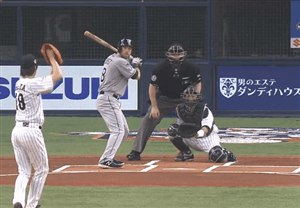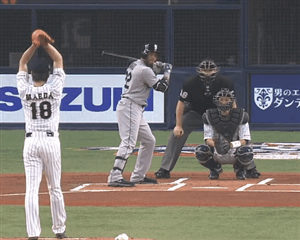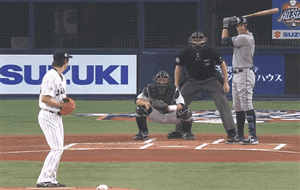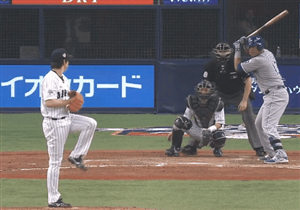Kenta Maeda a Dicey Proposition for D-backs
A handful of MLB players got a chance to see possible postee Kenta Maeda in Japan on November 12th, although if you were watching from home in Arizona, you were doing so at 1 am that morning. With that and GM Dave Stewart‘s recent public affection for Maeda (“I love Maeda“), it’s time to take a closer look at what he may bring to an MLB rotation.
Maeda has put up some impressive statistics in Nippon Professional Baseball for the Hiroshima Toyo Carp, 1,303.1 innings of 2.44 ERA ball, all before his 27th birthday. Maeda is similar to many Japanese pitchers who have made the transition to MLB in that he throws more than four pitches: four-seam, sinker, change, slider, curve. Yu Darvish has succeeded in a big way with a very varied repertoire (eight pitches?), though it would not be surprising if an MLB team asked him to shelve the curve. Still, Daisuke Matsuzaka‘s trail of mediocrity was preceded by the Red Sox asking him to narrow his repertoire, and maybe the best policy for a team that signs Maeda would be to do whatever the Red Sox didn’t.
Maeda has topped 200 innings three times already, a run in which he pitched 638 innings in three years 2010-2012 — and that’s a damned impressive accomplishment, what with the shorter 144-game NPB season (those 638 innings came in just 88 starts, good for a 7.25 inning-per-start average). Maeda slipped a bit to 175.2 and 187 innings in the last two seasons while fighting some bumps and bruises (including a short-lived bout of elbow tightness in April), but keep in mind that he still ranked fifth and second (respectively) in NPB’s Central League in innings pitched in those seasons. In fact, in the last two years, only one pitcher has topped 200 IP (Randy Messenger).
Smallish for a starting pitcher at six foot even, Maeda may be feeling some of the wear and tear that comes along with pitching so many innings. But he has been a horse for Hiroshima, and his chief contribution isn’t necessarily innings totals. If you toss out Maeda’s first two seasons, the second of which he started when he was just 20, his 2010-2014 ERA is just 2.18. That would be very impressive in Triple-A, and most consider the level of play in NPB to be somewhere between Triple-A and the majors (although it looks like the Central League is the weaker of the two in Japan).
No one expects Maeda to tally any 2.18 ERA seasons in the majors, but no one really has 2.18 ERA seasons in the majors, either. Putting aside questions of repertoire and raw stuff for a moment, take a look at how some other Japanese pitchers have fared in MLB just after transitioning:
In general, it looks like very good strikeout rates have translated to very good strikeout rates, although it’s hard to reconcile Kenshin Kawakami with Masahiro Tanaka in that regard. Several had outstanding WHIP marks (walks + hits per inning pitched), and the highest two (those of Kawakami, Kei Igawa) were the biggest flameouts in MLB. Walk rates in NPB also seem to correspond well with overall success in MLB.
That latter point is not great news for Maeda, whose BB/9 is the second highest in the group. Darvish and Matsuzaka saw their walk rates soar despite NPB rates that, on the surface, look pretty damned good. These seven past examples give us an impression that walk rates teeter on the edge of a knife; if you were outstanding in NPB, you may be able to keep that up on this side of the ocean. Not quite as good, and the wheels fall off. The baseball zeitgeist does tend to think that pitchers might nibble at the strike zone more in NPB. That would make many pitchers like Japanese versions of David Holmberg; it works very well if umpires call a larger strike zone and/or a larger chunk of hitters tend to chase, but it works very poorly otherwise.
It’s probably not quite as simple as simple walk rate. Another way to look at the past seven guys: contact management translates. Darvish and Hisashi Iwakuma had fantastic WHIP ratios in Japan, despite walk rates on the higher end of this list; and yet, while their walk rates did increase, they’ve both found a lot of success. Part of it is that strikeouts tend to have a greater run-depressing effect than other outs (because of base runners), but most of it appears to be contact management. Either guys are swinging through pitches, or they’re not making contact the way they’d like.
If WHIP is our guiding principle, then Maeda may have a real shot. With a somewhat higher walk rate and a better strikeout rate and WHIP, maybe Maeda will settle right in on the Hiroki Kuroda/Hisashi Iwakuma level of production; any team would take that gladly, and chances are pretty good that the market won’t pay Maeda what Kuroda or Iwakuma would currently command.
But given the past history of pitchers coming from NPB, it’s hard to form a good hypothesis of what Maeda will do. Conventional wisdom suggests he’ll be more of a #4 starter than the ace he has been in Japan; but conventional wisdom also said that Tanaka would be more of a decent #2, and before he got hurt he was one of the best pitchers in the league. So let’s dig a little deeper.
Watching Game 1 of the MLB All Stars series with Samurai Japan was interesting as hell, and it was not because of the pop music (a Cano single earned a clip of “Hey Baby” by Britney Spears; Longoria got treated to “Fancy” by Iggy Azalea while he was at the plate in the fourth). Maeda was fun to watch. With no PITCHf/x or even a broadcast radar gun, there’s only so much I can glean; the unusual (for us) camera angle didn’t help in terms of movement. But with the count even at 1-1, Maeda got Ben Zobrist out on a weak ground ball on a pitch he used as an out pitch all game, a curveball:
It appeared to be just off the plate, but that wasn’t the theme in his start, in my humble opinion. Maeda occasionally missed way off the plate, but seemed to hit the glove the vast majority of the time. Better that than missing a little bit all the time; Maeda didn’t make many mistakes.
It seemed like Maeda’s curveball had more depth than the MLB types anticipated. Here was Robinson Cano in the next at bat:
Have to include another curveball, so you can really see what I mean. Evan Longoria, also in the first inning:
Also note the big difference between his windup (first two) and the slide step he used while facing Longoria (Cano was on first). No change in command.
I focused on the curve because one of the theories in Boston when Matsuzaka started to struggle to find the plate was that the change in baseball had a very big effect. The Japanese baseball is a tiny bit smaller, but it’s also “tackier,” slicker, maybe a bit easier to grip and manipulate. In this All-Star series, the teams used MLB balls (except in the pre-series exhibition, when they kept switching depending on who was pitching). Hey, maybe Maeda did have a little bit less going on with the baseballs, but that’s not what the MLB hitters facing him were telling us with their actions. And he threw that curveball everywhere, including up and in to jam left-handed hitters (why don’t MLB pitchers do that more?).
He showed good pitchability throughout the game, and he wasn’t intimidated by the (very!) formidable lineup. He didn’t give in during battles, and he kept hitting spots, especially off the zone away from batters and up and in. It all looked so casual:
For all his success with the curveball, it did seem like the MLB players learned how to better handle Maeda as the game wore on. When he threw his fastball in but on the plate, they got handled; Cano hit a single on that pitch in the first, and Dexter Fowler sliced a double on it in the fifth. And Maeda was forced to throw more and more pitches in each at bat in successive innings.
The one thing that Maeda kept trying without success late in the game was getting hitters to swing at pitches away and off the zone. If he’s dependent on that approach, mixed success is going to snowball into no success. But I have a hard time believing he lives on it exclusively given the impressive innings totals he’s put up.
Overall, Maeda had an impressive start: no runs, 2 hits, 2 walks, and 2 strikeouts in five innings. He was on an 80-pitch limit, and after throwing his 71st pitch to get Zobrist on yet another ground out, Samurai Japan didn’t bother putting him back out there for the sixth. It was kind of a shame, because I think we could have drawn some better conclusions from how the MLB players handled at bats the third time through the order.
There’s a lot to like about Maeda, but a lot to be worried about, too. Based on a look at his numbers and a glimpse of his pitching, I’m not sure I agree that he translates as a low three or high four starter. His fastball seems hittable, and he’s not going to be able to live off the plate or get most MLB hitters to chase his secondary stuff low. It could all work, and Maeda could be a strong #2; it might not work, and a team could end up with a rocky #5. Maybe he’ll balance on the edge of a knife. I’d guess that he’ll have some above average seasons and some below average ones. For the D-backs, the dryness of the air and of Chase Field baseballs could exacerbate the differences between the MLB ball and the NPB ball, making Maeda an even dicier proposition for the D-backs specifically.
In this pitching market, Maeda is enticing given the lack of draft pick compensation, but considering the pick that the D-backs would be giving up would be a second rounder (although nearly as good as a comp pick), the $20M posting fee more than makes up for that. We also have to factor in the revenue boost that teams tend to see from signing a Japanese star, but I’ve looked at that before, and the boost from signing a pitcher is slimmer than for a position player, since fewer Japanese tourists are willing to make a trip not knowing if their favorite player will even play (although if they sign Maeda, the D-backs should think about marketing the home series against the Rangers over in Japan, given the especially high likelihood of a Japanese pitcher pitching).
It would not be surprising to see Maeda sign for something in the 6/$90M range. Around 6/$70, Maeda is a strong option for the D-backs, but I’m not sure we’ve seen enough for the team to go much higher than that.
4 Responses to Kenta Maeda a Dicey Proposition for D-backs
Leave a Reply Cancel reply
Recent Posts
@ryanpmorrison
 Congrats to @OutfieldGrass24 on a beautiful life, wedding and wife. He deserves all of it (they both do). And I cou… https://t.co/JzJtQ7TgdJ, Jul 23
Congrats to @OutfieldGrass24 on a beautiful life, wedding and wife. He deserves all of it (they both do). And I cou… https://t.co/JzJtQ7TgdJ, Jul 23 Best part of Peralta’s 108 mph fliner over the fence, IMHO: that he got that much leverage despite scooping it out… https://t.co/ivBrl76adF, Apr 08
Best part of Peralta’s 108 mph fliner over the fence, IMHO: that he got that much leverage despite scooping it out… https://t.co/ivBrl76adF, Apr 08 RT @OutfieldGrass24: If you're bored of watching Patrick Corbin get dudes out, you can check out my latest for @TheAthleticAZ. https://t.co/k1DymgY7zO, Apr 04
RT @OutfieldGrass24: If you're bored of watching Patrick Corbin get dudes out, you can check out my latest for @TheAthleticAZ. https://t.co/k1DymgY7zO, Apr 04 Of course, they may have overtaken the league lead for outs on the bases just now, also...
But in 2017, Arizona ha… https://t.co/38MBrr2D4b, Apr 04
Of course, they may have overtaken the league lead for outs on the bases just now, also...
But in 2017, Arizona ha… https://t.co/38MBrr2D4b, Apr 04 Prior to the games today, there had only been 5 steals of 3rd this season (and no CS) in the National League. The… https://t.co/gVVL84vPQ5, Apr 04
Prior to the games today, there had only been 5 steals of 3rd this season (and no CS) in the National League. The… https://t.co/gVVL84vPQ5, Apr 04
Powered by: Web Designers@outfieldgrass24
 RT @JesseNFriedman: Our final episode of @TheRattleAZ Podcast before Thursday’s season opener drops tonight! Send @OutfieldGrass24 and I your #Dbacks questions., 3 hours ago
RT @JesseNFriedman: Our final episode of @TheRattleAZ Podcast before Thursday’s season opener drops tonight! Send @OutfieldGrass24 and I your #Dbacks questions., 3 hours ago RT @OutfieldGrass24: Last spring, Ildemaro Vargas hit .395/.425/.605 and he's been DFA'd by three clubs since.
This spring, Josh Rojas… https://t.co/pD2cKrxYz2, 7 hours ago
RT @OutfieldGrass24: Last spring, Ildemaro Vargas hit .395/.425/.605 and he's been DFA'd by three clubs since.
This spring, Josh Rojas… https://t.co/pD2cKrxYz2, 7 hours ago Taylor Widener goes 5.2 innings today, 86 pitches , 58 strikes. He struck out seven and threw first-pitch strikes t… https://t.co/7WnpeGTQEv, 4 hours ago
Taylor Widener goes 5.2 innings today, 86 pitches , 58 strikes. He struck out seven and threw first-pitch strikes t… https://t.co/7WnpeGTQEv, 4 hours ago This is such a different Taylor Widener than we saw a year ago. #Dbacks, 5 hours ago
This is such a different Taylor Widener than we saw a year ago. #Dbacks, 5 hours ago Hi, my name's Ketel Marte and I hit absolute missiles. What's your name?, 5 hours ago
Hi, my name's Ketel Marte and I hit absolute missiles. What's your name?, 5 hours ago
Powered by: Web Designers










I would be excited if they somehow managed to add Maeda. You’re right though; you never know those guys will turn out. But that’s true of anybody I suppose.
In light of TLR’s recent comments regarding the team not being in a full rebuild and not being patient about making the organization successful, do you think that the $90 million mark isn’t a sincere goal?
I think the $90M is about managing expectations. I think Hall’s comments about factoring in the cost of the suddenly high draft picks is also about managing expectations.
There’s no way for them to get under that, unless they move Cahill and/or Hill… and even then, assuming they’d have to eat some money (and not trade a prospect to do it, like Towers did with Holmberg/Bell.. that was great), it leaves very, very little room.
The $20M posting fee is also not trivial, but I don’t know how they would approach that. And I think there’s a zero chance that the posting fee is less… someone will post $20M, and everyone should know that. So any club might as well bid $20M, or just not bid.
Will be interesting to watch.
Excellent use of GIFs. Better use of “profit.”
[…] as a dicey but promising proposition, no more or less than I did at the end of last season, after seeing a Maeda start against a team of MLB All-Stars. It’s still a good idea, in the same ways and to the same […]